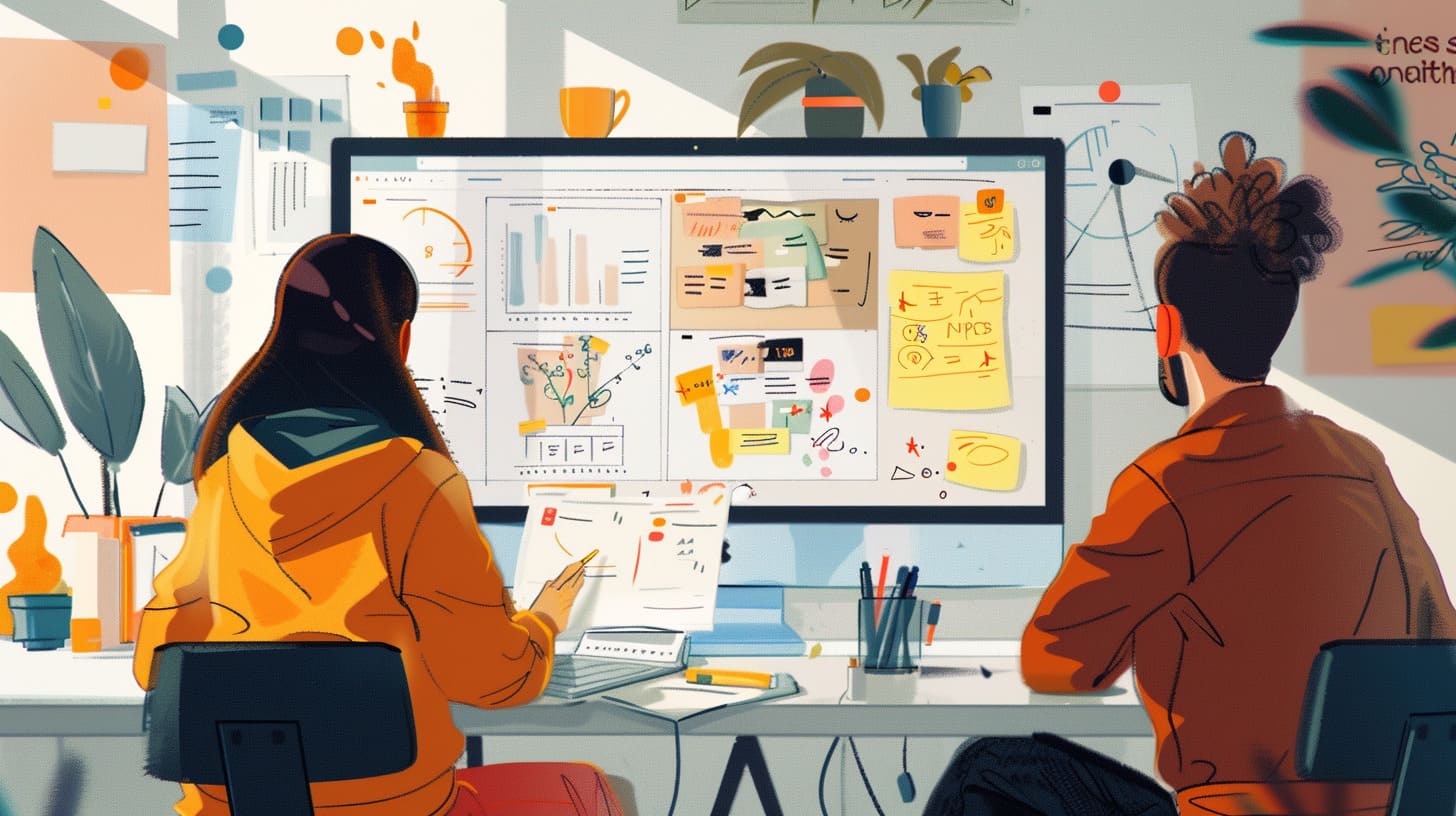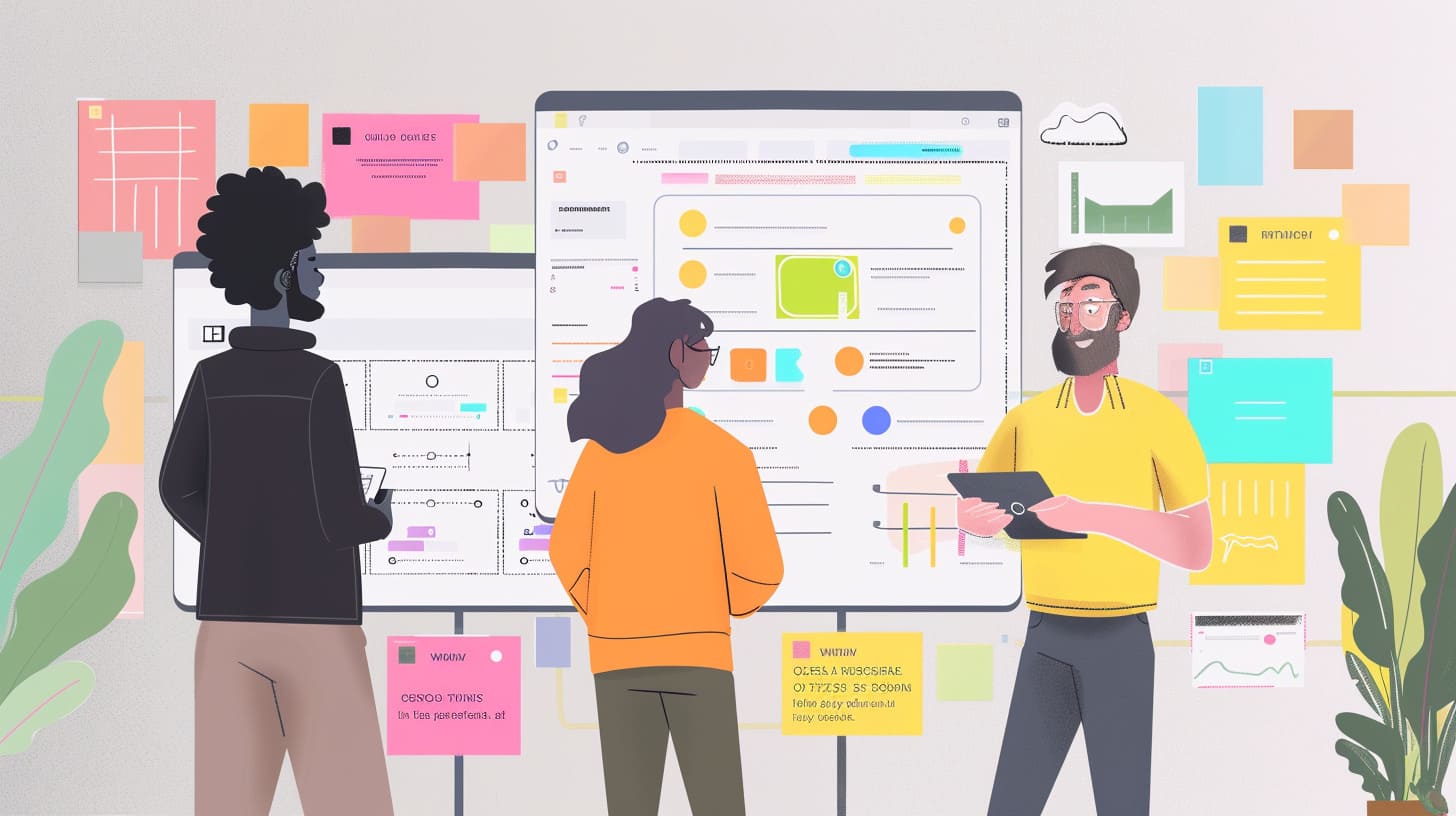In today’s competitive design industry, training junior designers is essential for fostering creativity, innovation, and a steady flow of new ideas. This article outlines effective strategies for training junior designers, combining mentoring, technology, cross-functional training, and more to create a comprehensive learning experience.
The Power of Mentoring and Coaching
One-on-one mentoring is a powerful tool for developing junior designers. The benefits of this personalized approach extend beyond mere skill enhancement, positively impacting overall productivity and job satisfaction.
Improved Skill Development
When junior designers receive individual attention, their skills grow significantly. According to a 2019 study published in the Journal of Design Research, one-on-one mentoring leads to notable improvements in key areas such as communication, problem-solving, and time management. These skills are critical for a designer’s success and can be honed more effectively through dedicated, tailored guidance.
Increased Productivity
The productivity gains from mentoring are substantial. A 2020 study by the Design Management Institute found that designers who had regular mentoring sessions experienced a 25% increase in productivity. This improvement is attributed to the structured support and feedback provided by mentors, which helps junior designers navigate their tasks more efficiently and effectively.
Enhanced Job Satisfaction
Job satisfaction also sees a significant boost with one-on-one mentoring. The American Institute of Graphic Design (AIGA) conducted a survey in 2018 revealing that 71% of designers felt mentoring had a significant impact on their career development. Furthermore, 64% reported that mentoring improved their job performance. This satisfaction stems from the personalized attention and career guidance that mentoring provides, fostering a more engaging and fulfilling work experience.
Example: A Study by the American Society for Training and Development
The American Society for Training and Development conducted a study highlighting the impact of mentoring on professional development. The study found that structured mentoring programs led to higher retention rates and better performance outcomes. Junior designers who participated in these programs not only developed their technical skills but also gained valuable insights into industry practices and workplace dynamics.
Key Mentoring Techniques and Strategies

Effective mentoring requires specific techniques and strategies to maximize learning and performance outcomes:
- Goal-Setting and Feedback:
- Setting clear, achievable goals
- Providing regular, constructive feedback
- Active Listening and Questioning:
- Encouraging critical thinking through active listening
- Using probing questions to stimulate problem-solving
- Encouraging Self-Reflection:
- Promoting self-awareness through reflective practices
- Developing a growth mindset
Latest Trends in Mentoring and Coaching
Leading design companies are continuously evolving their mentoring and coaching strategies to stay ahead. Here are some recent trends:
- Structured Mentorship Programs:
- Defined goals and objectives
- Regular check-ins and feedback sessions
- Incorporating Coaching Techniques:
- Using design thinking principles
- Focusing on soft skills like communication and collaboration
- Utilizing Digital Platforms:
- Online mentorship programs
- AI-powered coaching tools
By adopting these best practices, you can create a robust and effective mentoring program that not only improves skills but also enhances productivity and job satisfaction among junior designers.
Leveraging Technology Tools
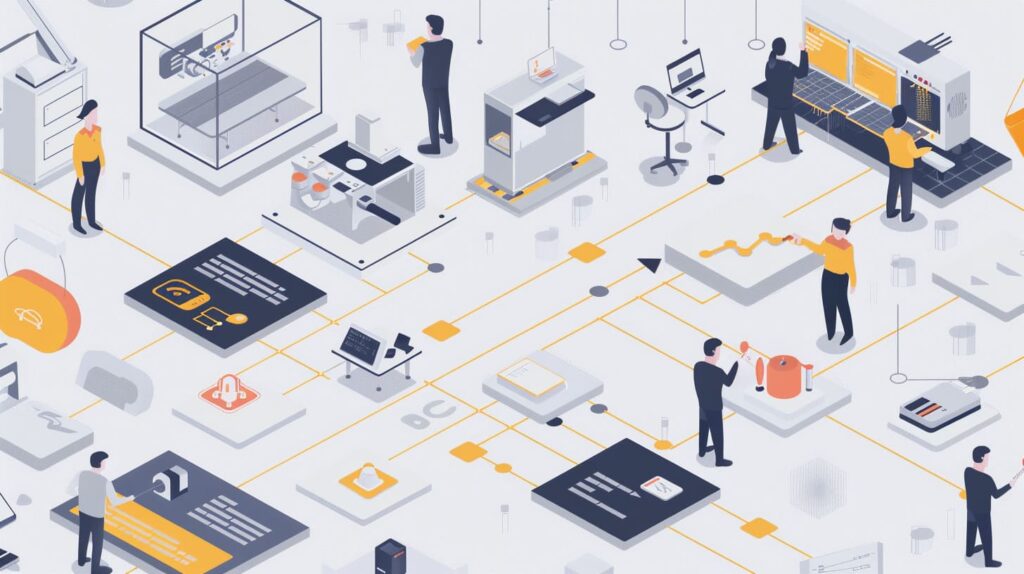
In the rapidly evolving design industry, cloud-based tools like Figma, Sketch, and Adobe XD have become indispensable. These tools offer several advantages that enhance real-time collaboration and file sharing, making them ideal for training junior designers.
Advantages of Cloud-Based Design Tools
Figma:
- Multi-player Editing: Figma allows multiple users to work on a design file simultaneously. This feature is invaluable for team collaboration, especially when mentoring junior designers.
- Real-time Commenting: Team members can leave comments and feedback in real-time, facilitating immediate improvements and learning.
- Version History: This allows designers to track changes and revert to previous versions, which is useful for training as it helps junior designers understand the evolution of a design.
- Tool Integrations: Figma integrates with Slack, Jira, and GitHub, enhancing workflow and collaboration.
Sketch:
- Real-time Collaboration: Similar to Figma, Sketch enables multiple users to work on a file at the same time, making it easier to mentor junior designers through hands-on training.
- Cloud-based File Sharing: Easily share design files with team members and stakeholders, eliminating the hassle of email attachments.
- Version Control: Track changes and collaborate without worrying about file conflicts.
- Integrations: Sketch integrates with Zeplin, InVision, and GitHub, streamlining the design process.
Adobe XD:
- Co-editing: Multiple users can edit a design file simultaneously, facilitating real-time learning and feedback.
- Real-time Commenting: Like Figma, Adobe XD allows for real-time comments, making it easier to provide immediate feedback.
- Cloud-based File Sharing: Share designs effortlessly with team members and stakeholders.
- Adobe Integrations: Seamlessly integrates with other Adobe tools like Photoshop and Illustrator, providing a comprehensive design environment.
Benefits of Using Cloud-Based Design Tools
- Real-time Collaboration: Enhance team collaboration by allowing multiple users to work on a design file simultaneously.
- Easy File Sharing: Simplify file sharing with team members and stakeholders, reducing email attachments and version control issues.
- Version Control: Track changes and collaborate without worrying about file conflicts.
- Accessibility: Access design tools from anywhere, making it easier for remote teams to collaborate.
- Scalability: Scale up to meet the needs of growing teams and projects without expensive hardware upgrades.
Case Studies and Success Stories
- Figma & Airbnb: Airbnb used Figma to redesign their website, reducing design time by 50% and increasing design quality by 30%.
- Sketch & IBM: IBM leveraged Sketch for their Watson platform, resulting in a 40% reduction in design time and a 25% increase in design quality.
- Adobe XD & SAP: SAP utilized Adobe XD for their Fiori platform, achieving a 30% reduction in design time and a 20% increase in design quality.
These examples highlight how cloud-based design tools can significantly improve project outcomes and team efficiency. By leveraging these tools, you can create a collaborative and productive environment that is essential for training junior designers.
Creating an Effective Onboarding Program
A well-defined onboarding plan is the cornerstone of an effective training program for junior designers. This structured approach helps new hires quickly adapt to their roles and the company’s culture, ensuring they become productive team members as soon as possible.
Personalizing the onboarding process can significantly enhance its effectiveness. Tailor the experience to the junior designer’s needs, skills, and learning style. Clear goals and objectives should be established using the SMART criteria—specific, measurable, achievable, relevant, and time-bound—to guide the onboarding period.
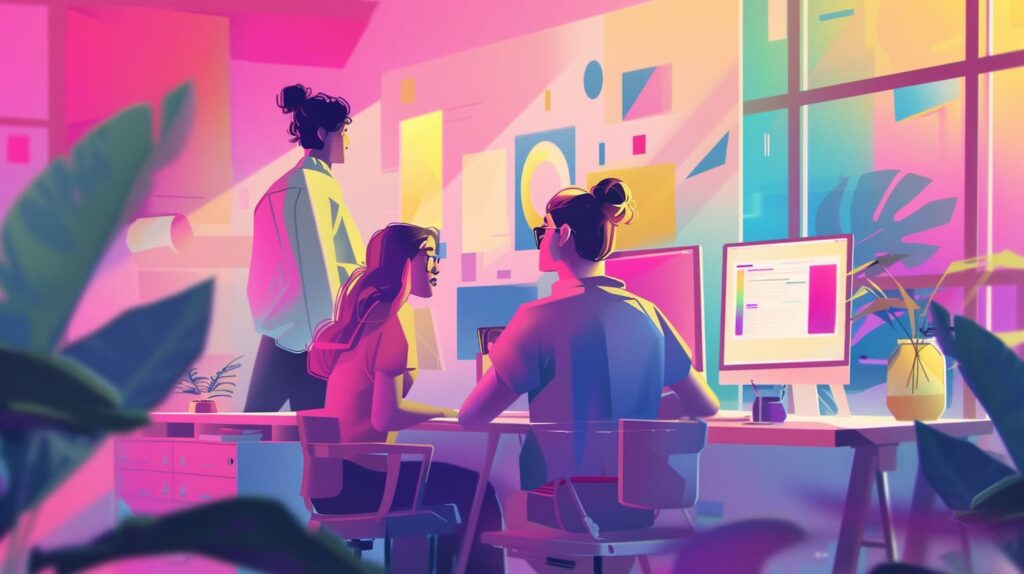
Interactive training sessions that incorporate hands-on design exercises, workshops, and feedback sessions facilitate learning by doing. These activities help junior designers grasp complex design principles more effectively than traditional lectures.
Assigning mentors and onboarding buddies to junior designers provides them with ongoing support and guidance. Mentors, who are usually experienced designers, can offer valuable insights and feedback. Onboarding buddies, typically peers, can assist with navigating company processes and culture.
Regular check-ins are crucial for maintaining momentum. Schedule frequent meetings to discuss progress, provide feedback, and address any concerns. This practice ensures that junior designers feel supported and can promptly resolve any issues they encounter.
Essential Components: Company Culture, Team Introductions, Role Expectations

Company culture plays a pivotal role in the onboarding process. A positive and inclusive culture makes junior designers feel welcomed and valued. When they understand the company’s values and how they align with their work, they are more motivated and engaged.
Introducing junior designers to the team and key stakeholders facilitates collaboration and open communication. It helps them build relationships that are essential for effective teamwork. Knowing who to turn to for help or feedback can reduce anxiety and foster a sense of belonging.
Clear role expectations are another critical component. Define the junior designer’s responsibilities and performance expectations from the outset. This clarity helps avoid confusion, ensuring that new hires understand their contributions to the team.
Key Components of an Effective Onboarding Program:
| Component | Description |
|---|---|
| Personalized Onboarding | Tailor the process to individual needs and skills. |
| Clear Goals | Establish SMART goals for the onboarding period. |
| Mentorship Programs | Pair new hires with experienced mentors. |
| Interactive Training | Use hands-on exercises and workshops. |
| Regular Check-ins | Schedule frequent progress meetings. |
| Company Culture | Foster a positive and inclusive environment. |
| Team Introductions | Facilitate relationships with team and stakeholders. |
| Clear Role Expectations | Define roles and responsibilities clearly. |
In summary, a comprehensive onboarding program that includes these elements can effectively train junior designers, helping them quickly adapt and thrive in their new roles.
Implementing Cross-Functional Training

Understanding Other Team Roles
Cross-functional training involves educating team members about the roles, responsibilities, and workflows of other departments. This approach fosters a holistic understanding of the project, leading to more cohesive teamwork and better overall outcomes.
Benefits of Cross-Functional Training
Cross-functional training offers numerous benefits:
- Improved Collaboration: By understanding each other’s roles, team members can communicate more effectively. This leads to smoother workflows and reduces conflicts.
- Enhanced Problem-Solving Skills: Exposure to different perspectives enables team members to approach problems with a broader understanding, leading to more innovative solutions.
- Increased Design Quality: When designers understand the technical constraints and possibilities from other departments, they can create more feasible and higher-quality designs.
Recent case studies highlight these benefits:
- Airbnb’s Cross-Functional Design Team: Implementing cross-functional training resulted in a 30% increase in design velocity and improved collaboration.
- IBM’s Design Thinking Training: This program saw a 25% increase in innovation and a 20% increase in collaboration.
- Microsoft’s Cross-Functional Design Team: Their program led to a 25% increase in design quality and a 15% increase in customer satisfaction.
These outcomes underline the importance of cross-functional training in achieving higher efficiency and better design outcomes.
Effective Communication and Collaboration
Effective communication is the backbone of any successful cross-functional training program. Here are some tools and strategies that can enhance communication and collaboration:
- Communication Platforms: Tools like Slack and Microsoft Teams provide centralized hubs for team communication, file sharing, and project management.
- Project Management Tools: Asana and Trello offer visual representations of project tasks, deadlines, and progress, aiding team coordination.
- Design Collaboration Tools: Figma and InVision enable real-time design collaboration, allowing team members to work together seamlessly.
- Virtual Whiteboard Tools: Tools like Mural and Google Jamboard facilitate remote brainstorming sessions, making it easier for teams to collaborate, regardless of their physical location.
These tools help in:
- Reducing misunderstandings through clear communication.
- Providing a centralized platform for managing projects and sharing files.
- Enabling real-time feedback and collaboration, which is crucial for iterative design processes.
- Facilitating remote work and virtual collaboration, which is increasingly important in today’s global work environment.
Best Practices for Cross-Functional Training
To implement an effective cross-functional training program, consider the following best practices:
- Define Clear Goals and Objectives: Establish specific goals for your training program to ensure alignment and focus.
- Identify Key Skills and Knowledge Gaps: Assess your team’s current skills and identify areas that need improvement.
- Develop a Structured Training Program: Combine theoretical knowledge with practical exercises, and include opportunities for feedback and iteration.
- Encourage Active Participation and Feedback: Foster an environment where team members feel encouraged to participate and provide feedback.
- Provide Opportunities for Practice and Application: Allow team members to apply their new skills in real-world projects.
- Lead by Example: Managers should demonstrate a commitment to cross-functional training and collaboration.
- Monitor Progress and Evaluate Outcomes: Regularly assess the effectiveness of your training program and make adjustments as needed.
By adhering to these best practices, you can create a cross-functional training program that not only enhances individual skills but also improves overall team performance.
Cross-functional training is a vital strategy for fostering a collaborative and innovative design team. By understanding other team roles and leveraging effective communication tools, you can significantly enhance the quality and efficiency of your design projects.
Providing Constructive Feedback

Regular feedback is crucial for the growth and development of junior designers. Timely and actionable feedback helps them understand their strengths and areas for improvement, fostering continuous improvement and skill enhancement.
Importance of Regular Feedback
Regular feedback has numerous benefits for junior designers. Here’s why it matters:
- Timely and Actionable Feedback: When you provide feedback regularly, it allows junior designers to make necessary adjustments in real-time. This not only improves the quality of their current work but also helps them develop better design habits over time. Aim to offer specific, actionable suggestions rather than vague comments.
- Continuous Improvement: Regular feedback sessions encourage ongoing learning and development. Junior designers can gauge their progress, understand what works and what doesn’t, and apply this knowledge to future projects. This continuous loop of feedback and improvement leads to faster skill development.
- Increased Confidence: Constructive feedback can boost the confidence of junior designers. Knowing that their work is being reviewed and refined helps them feel supported and motivated. This confidence encourages them to take on more challenging projects and push their creative boundaries.
- Better Problem-Solving: By receiving regular feedback, junior designers can develop strong problem-solving skills. They learn to think critically, analyze their work, and come up with innovative solutions to design challenges.
Techniques for Providing Effective Feedback
Implementing the right techniques can make feedback more meaningful and impactful. Here are some best practices:
- Regular Check-ins: Schedule consistent one-on-one meetings to discuss progress, challenges, and goals. These sessions provide a structured environment for giving and receiving feedback.
- Specific and Actionable Feedback: Focus on particular elements of the design and offer clear, actionable suggestions. Instead of saying, “This design needs improvement,” specify, “The color palette could be more cohesive to enhance visual appeal.”
- Feedback Sandwich: Use the feedback sandwich technique, where you start with positive feedback, followed by constructive criticism, and end with positive remarks. This approach helps balance the feedback and makes it more palatable.
- Design Critiques: Conduct group critiques to foster a culture of peer feedback. This not only helps junior designers learn from each other but also builds a sense of community within the team.
- Self-Assessment: Encourage junior designers to evaluate their own work. Self-assessment helps them identify their strengths and weaknesses and promotes a sense of ownership over their development.
- Real-Time Feedback: Provide feedback during the design process instead of waiting until the end. Real-time feedback helps junior designers make immediate improvements and learn more effectively.
Impact of Constructive Feedback on Skill Development
The impact of regular, constructive feedback on junior designers is substantial:
- Improved Design Quality: Regular feedback helps refine design skills, leading to higher-quality outputs.
- Faster Skill Development: Frequent feedback accelerates learning, allowing junior designers to quickly address and improve their weak areas.
- Enhanced Critical Thinking: Continuous feedback promotes critical thinking, enabling designers to analyze and improve their work independently.
- Professional Growth: Constructive feedback fosters a growth mindset, preparing junior designers for future leadership roles.
Feedback Tools and Platforms
Modern feedback tools can streamline the process, making it easier to provide timely and actionable feedback. Here are some tools to consider:
| Tool | Features |
|---|---|
| Figma | Real-time feedback and collaboration features |
| InVision | Built-in feedback tools like “Freehand” |
| Notion | Custom feedback templates and workflows |
| Mural | Digital workspace with anonymous feedback mode |
| Loom | Video recording for asynchronous feedback |
| 15Five | Continuous feedback and performance management |
| Gather | Platform with specific features for design critiques |
By using these techniques and tools, you can provide junior designers with the constructive feedback they need to grow and succeed in their roles.
Fostering Diversity and Inclusion

Diversity in design teams is not just a buzzword; it significantly boosts innovation and productivity. Various studies and real-world examples support the idea that bringing together individuals from different backgrounds, experiences, and perspectives leads to superior outcomes.
Increased Innovation and Productivity
- Enhanced Creativity: Diverse teams bring different perspectives, which results in more creative problem-solving. A study by Harvard Business Review (2019) found that diverse teams are more likely to come up with innovative solutions.
- Better Decision-Making: The University of Michigan (2015) discovered that diverse teams generate more novel solutions and identify potential pitfalls faster than homogenous teams.
- Higher Revenue: According to McKinsey (2020), companies with diverse workforces, especially those with more than 25% women in executive positions, are more likely to outperform industry averages in revenue generation from new products and services.
Studies Supporting Diversity in Teams
- Design Management Institute (2019): Found that diverse design teams are more likely to develop innovative solutions that meet a broader range of user needs.
- Journal of Product Innovation Management (2018): Demonstrated that diverse teams are more effective at generating a wide range of ideas and solutions, enhancing innovation performance.
- University of California, Berkeley (2014): Concluded that diverse teams are more likely to engage in constructive conflict, leading to better decision-making and more innovative solutions.
- University of Texas at Austin (2013): Found that diverse teams are more adept at identifying and challenging assumptions, resulting in more effective solutions.
These findings highlight the tangible benefits of fostering diversity in design teams. It’s clear that diversity isn’t just a moral imperative but a strategic advantage.
Real-World Examples of Success with Diverse Teams
Companies that prioritize diversity and inclusion in their design teams often see a noticeable boost in innovation and productivity. Here are some examples:
- Airbnb: By implementing blind hiring practices, diversity and inclusion training, and employee resource groups, Airbnb has increased its innovative solutions and diversified its range of products and services.
- IBM: IBM’s focus on diversity through mentorship programs and employee resource groups has led to increased innovation and a wider variety of products and services.
- Microsoft: With initiatives like inclusive design principles and diversity training, Microsoft has seen a surge in innovative solutions and more diverse products.
- The Design Council: This UK-based organization has seen an increase in innovative solutions due to its diversity and inclusion training, mentorship programs, and employee resource groups.
Key Takeaways
- Different Perspectives Lead to Innovation: Diverse teams provide a broader range of ideas and solutions.
- Enhanced Problem-Solving: Diverse teams are better at identifying pitfalls and coming up with creative solutions.
- Increased Revenue: Companies with diverse teams are more likely to outperform industry averages.
Checklist for Fostering Diversity
- Implement blind hiring practices.
- Conduct diversity and inclusion training.
- Establish mentorship programs for underrepresented groups.
- Create employee resource groups.
- Promote open communication and recognize diverse perspectives.
By prioritizing diversity and inclusion, design teams can unlock their full potential, leading to increased innovation and productivity. This approach not only benefits the team but also contributes to the development of products and services that cater to a wider audience.
Up-Skilling and Re-Skilling Opportunities
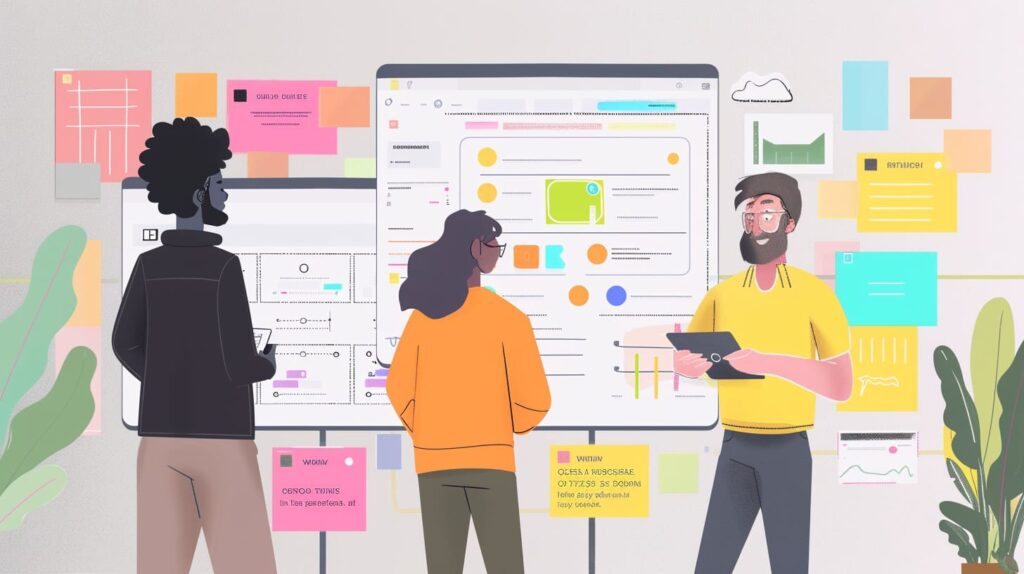
In the fast-paced world of design, keeping up with industry trends is crucial for junior designers. Continuous learning helps you stay relevant and competitive. Let’s explore how you can do this effectively.
Importance of Continuous Learning
The design industry is ever-evolving, with new tools, techniques, and trends emerging regularly. Embracing continuous learning ensures you adapt and grow with these changes, keeping your skills sharp and up-to-date. Here’s why it’s essential:
- Staying Competitive: Continuous learning helps you stay ahead of the curve, making you a valuable asset to any team.
- Career Growth: Keeping your skills current opens doors to new opportunities and career advancements.
- Innovation: Exposure to new ideas and trends fosters creativity and innovation in your work.
Providing Access to Workshops, Training Sessions, and Online Courses
To support your continuous learning journey, accessing various educational resources is vital. Here are some effective ways to do it:
1. Workshops and Training Sessions: Investing time in workshops and training sessions can significantly enhance your skills. These sessions provide hands-on experience and direct interaction with experts in the field.
- DesignThinkers: Offers workshops on cutting-edge design thinking methodologies.
- UX Design Summit: Focuses on user experience design trends and best practices.
- Adobe MAX: A premier event for creatives, offering numerous sessions on the latest Adobe tools and design techniques.
2. Online Courses: Online courses offer flexible learning options that can fit into your schedule. They cover a broad range of topics, from basic design principles to advanced techniques.
- Coursera: Provides comprehensive design specializations.
- Udemy: Offers a variety of design courses for different skill levels.
- Skillshare: Known for its interactive design classes.
- LinkedIn Learning: Features courses from industry experts on various design topics.
3. Design Communities and Forums: Engaging with design communities and forums allows you to learn from peers, share your work, and get valuable feedback.
- Dribbble: A community of designers showcasing their work.
- Behance: Platform for creatives to display their portfolios.
- Reddit (r/design): A forum where designers discuss trends, share resources, and seek advice.
4. Design Blogs and Resources: Regularly reading design blogs and resources keeps you informed about the latest trends and best practices.
- Smashing Magazine: Covers a wide range of design and web development topics.
- Designmodo: Offers tutorials and articles on design trends.
- UX Collective: A blog focused on user experience design.
- Nielsen Norman Group (NN/g): Provides research-based insights on UX design.
By integrating these resources into your routine, you can steadily enhance your skills and stay updated with the latest trends. Continuous learning is not just about keeping pace with the industry, but also about pushing the boundaries of your creativity and expertise.
Providing Real-World Experience
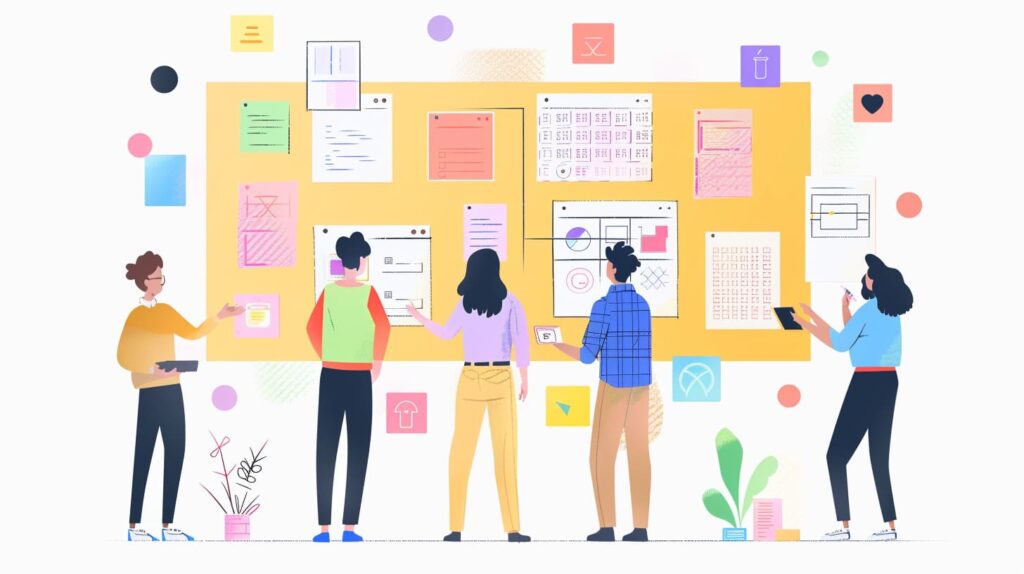
Practical experience is a cornerstone of effective training for junior designers. Engaging in real-world projects not only boosts technical skills but also accelerates professional growth. By working on actual assignments, junior designers gain a deeper understanding of industry demands and client expectations.
Working on Real Projects
Real-world projects offer invaluable learning opportunities. These projects simulate the conditions designers will face in their professional careers. By tackling real challenges, junior designers develop critical thinking and problem-solving abilities. Here’s how you can integrate real projects into training:
- Project-Based Learning: This method involves assigning tasks that replicate professional design work. It encourages junior designers to apply theoretical knowledge in practical scenarios.
- Design Sprints: Short, intensive projects help junior designers adapt to the fast-paced nature of the industry. They learn to deliver quality work within tight deadlines, improving their time management skills.
- Virtual Design Studios: Working in a virtual environment mimics the remote work setups common in modern design firms. This approach enhances skills in communication and collaboration, crucial for distributed teams.
Collaboration with Clients
Collaborating directly with clients during training can significantly enhance a junior designer’s skill set. This experience provides insights into client relationships, project management, and the iterative nature of design work.
- Improved Communication Skills: Junior designers learn to articulate design concepts and understand client feedback. Effective communication is vital for translating client needs into successful designs.
- Enhanced Problem-Solving Skills: Real-world projects often come with unique challenges. By addressing these issues, junior designers sharpen their problem-solving abilities.
- Increased Confidence: Successfully managing client projects boosts confidence. Positive client feedback reinforces their belief in their capabilities.
- Better Understanding of Client Needs: Exposure to various clients helps junior designers develop a keen sense of what clients expect, leading to more effective and targeted designs.
Benefits of Real-World Projects
Engaging in practical experiences prepares junior designers for the multifaceted nature of their roles. Here are some benefits:
- Portfolio Development: Real-world projects provide tangible evidence of skills and creativity, enhancing job prospects.
- Networking Opportunities: Collaborating with clients and industry professionals expands their professional network.
- Skill Diversification: Exposure to different project types and client requirements broadens their skill set.
Effective Strategies for Integrating Practical Experience
To maximize the benefits of practical experience, adopt these strategies:
- Mentorship Programs: Pair junior designers with seasoned professionals who can offer guidance and feedback.
- Industry Partnerships: Collaborate with industry leaders to provide authentic project experiences.
- Design Challenges: Present real-world scenarios for junior designers to solve, fostering practical skills.
- Feedback and Iteration: Regular feedback sessions help junior designers refine their work and learn from mistakes.
By incorporating real-world experience into training programs, you ensure that junior designers are well-equipped to meet the demands of the industry. This practical approach not only enhances their skills but also prepares them for a successful career in design.
Conclusion
Training junior designers requires a comprehensive approach that includes mentoring, technology, cross-functional training, feedback, diversity and inclusion, up-skilling, and real-world experience. By creating a supportive and collaborative environment, you can help junior designers grow and contribute to the team’s success, ensuring a continuous flow of creativity and innovation.
Several recent developments in design training methodologies have proven effective in supporting the growth of junior designers. These include:
- Mentorship programs: Pairing junior designers with experienced mentors who provide guidance, feedback, and support.
- Project-based learning: Assigning real-world projects that allow junior designers to apply their skills and knowledge in a practical setting.
- Design sprints: Conducting time-boxed design challenges that encourage collaboration, creativity, and problem-solving.
- Feedback loops: Establishing regular feedback sessions to help junior designers refine their skills and address areas for improvement.
- Cross-functional training: Providing training that spans multiple design disciplines, such as UX, UI, and visual design, to foster a more holistic understanding of design.
- Online learning platforms: Utilizing online platforms, such as Designlab, Udemy, and Skillshare, to offer flexible, self-paced learning opportunities.
Incorporating diversity and inclusion in your training programs is also crucial. Current industry leaders effectively integrate these elements by:
- Creating inclusive design exercises: Developing design challenges that focus on diverse user needs, abilities, and perspectives.
- Providing diverse mentorship: Pairing junior designers with mentors from diverse backgrounds and experiences.
- Fostering open communication: Encouraging open dialogue and feedback to create a safe and inclusive learning environment.
- Addressing bias in design: Educating junior designers on the importance of recognizing and addressing bias in design decisions.
- Celebrating diverse design perspectives: Showcasing the work and experiences of designers from diverse backgrounds to promote a culture of inclusion.
- Offering flexible training options: Providing flexible training schedules and formats to accommodate different learning styles and needs.
The latest tools and technologies being utilized to provide real-world experience for junior designers in a professional setting include:
- Design collaboration tools: Utilizing tools like Figma, Sketch, and Adobe XD to facilitate collaboration and feedback.
- Prototyping tools: Using tools like InVision, Prototyper, and Axure to create interactive prototypes and test designs.
- Virtual design environments: Creating immersive design experiences using virtual reality (VR) and augmented reality (AR) technologies.
- Design systems and style guides: Implementing design systems and style guides to promote consistency and efficiency in design development.
- Agile project management tools: Utilizing tools like Jira, Asana, and Trello to manage design projects and workflows.
- Real-world design challenges: Partnering with real clients or organizations to provide junior designers with authentic design challenges and projects.
